X872
Contents
Overview
August 6th 2024, we release a NEW X872 V2.0 and X873 V2.0.
This is the X872 NVMe M.2 SSD Storage Expansion Board for Raspbeerry Pi 4 model B, it provides a complete storage solution for raspberry pi 4. It supports multiple M.2 NVMe SSD lengths including: 2280, 2260, 2242, 2230. X872 is upgraded from X870 and basically redesigned in X870, you can use it as a mobile SSD hard also.
Important NOTE:
This X872 is not fit to ROCK64 and Raspberry Pi 3B+ /3B because the difference of USB 3 position. Please refet to X870 if you want use NVMe ssd on the Raspberry Pi 3B+/3B or ROCK64 board.
Raspberry Pi 4 M.2 NVMe, M.2 SATA, mSATA Shield:
| Product Name | Compatible with | Socket | Power Requirement | Matching Case | Extra Cooling Solution Recommended | Installation Video |
|---|---|---|---|---|---|---|
| X862 V2.0 | Raspberry Pi 4 | M.2 SATA Key-B NGFF SSD 2280 | USB C 5Vdc +/-5% , ≥4A | X735/ |
Click to play | |
| X863 | Raspberry Pi 4 | M.2 SATA Key-B NGFF SSD 2280 | USB C 5Vdc +/-5% , ≥4A | X863-C1 | X732 | Click to play |
| X876 | Raspberry Pi 4 | M.2 NVMe Key-M 2280 | USB C 5Vdc +/-5% , ≥4A | X863-C1 | X732 | Click to play |
| X873 V2.0 | Raspberry Pi 4 | M.2 NVMe Key-M 2280 | USB C 5Vdc +/-5% , ≥4A | NO Matching Case yet | - | - |
| X872 V2.0 | Raspberry Pi 4 | M.2 NVMe Key-M 2280 | USB C 5Vdc +/-5% , ≥4A | X735/ |
- | |
| Raspberry Pi 4 | mSATA SSD | USB C 5Vdc +/-5% , ≥4A | X735/ |
Click to play |
Features
- Ideal storage solution only for Raspberry Pi 4 - M.2 NVMe SSD Shield
- Supports up to 2TB M.2 NVMe SSD solid-state drives
- Supports multiple M.2 NVMe SSD lengths including: 2280, 2260, 2242, 2230,additional spacer required for SSD lengths 2260, 2242 and 2230 (not supplied with X872)
- Allows booting OS from your HDD/SSD for faster app opens, web serving and file copying (see FAQ 1)
- USB3.1 Gen1 5Gb/s connectivity offers plug-and-play functionality on your Raspberry Pi 4
- Ultra-fast Data Transfers from a PC or a Mac (USB3.1 Gen2 10Gb/s, Gen1 5Gb/s, USB2.0 480Mb/s)
- Integrated USB 3.1 Gen2 to PCIe Gen3x2 10Gb/s bridge controller
- Integrated high efficiency step-Down Converter, 3.3V max3.5A to power the SSD
- External self-powered or USB bus-powered
- Onboard DC 55x25 jack & XH2.54 connector for extra SSD power supply
- LED red indicator indicates powered status and blue indicator indicates drive status
- Specially-made USB3.1 jumper to connect with Raspberry Pi - no cabling required!
- Fully compatible with X735 for intelligent power management and cooling your Raspberry Pi
- Fully compatible with X710 for wide input voltage (6~36V) and intelligent power management
- Fully compatible with X765 for powering over Ethernet (POE, 5V 5A)
- Fully compatible with X725 for uninterruptible power supply (18650 UPS, 5.1V 8A, WOL)
SPECIFICATION
Power Supply
- 5Vdc +/-5% , Powered by Raspberry Pi USB port
- 5Vdc via DC power jack or XH2.5 connector, Extra power for the SSD
Ports & Connectors
- 1x USB A socket
- 1x DC power jack 5.5*2.5mm
- 1x XH2.54 power connector
- 1x 67Pin M.2 connector P=0.5mm, H3.2mm, Key M
PCB Size
- 87mm x 56mm
==NOTES
- Additional spacer required for SSD lengths 2260, 2242 and 2230 (not supplied with X872)
- A microSD card is required for forcing the Raspbian OS to use the HDD/SSD for its "root" partition
- Only compatible with NVMe M.2 SSDs
- Not compatible with M.2 SATA SSDs, M.2 PCIe AHCI SSDs, or other M.2 non-NVMe devices
- As with all SSDs, new media must be formatted before use, please refer to Tutorial Initalize New SSD
- SSDs use exceptionally high performance storage media that will run hot when under load
- Older SSD drives with less efficient flash media may not perform as well as newer drives
- USB 3.0 devices might generate radio frequency interference that can cause Wi-Fi and other wireless devices operating in the 2.4GHz band to have issues communicating with your Raspberry Pi4. To avoid interference on the 2.4GHz band using Wi-Fi, try using the 5GHz band instead. If problem still exists, please turn off WiFi and use the wired network instead.
Installation Guide
Packing List
- 1 x X872 M.2 NVME SSD shield (Not include the NVMe SSD)
- 1 x USB3.1 jumper / Connector
- 4 x Spacer M/F M2.5 x 12mm
- 4 x Spacer F/F M2.5 x 8mm
- 4 x Screw M2.5 x 6mm
- 1 x SSD Screw driver
- 1 x Screw M2 *4mm
Some Tips
- Properly Mount USB Storage on Raspberry Pi
- Auto Mount an NTFS USB Drive on Raspberry Pi
- From customer: https://github.com/hoopsurfer/pdx/blob/master/installX872.md
- About USB boot please refer to Does the X825/X855 support USB boot
- Raspberry Pi Storage Benchmarks: https://jamesachambers.com/raspberry-pi-storage-benchmarks/
- How to Install an M.2 hard drive on a Raspberry Pi 4 ? Thanks John MacDowall!
FAQ
Q0: What to do if you find the SSD is not recognize?
A: 1. Please confirm that you use the SSD with right interface which match with the socket of your expansion shield. (Not recommend to use SAMSUNG SSD, as there will be BIG EMC interference.)
2. If use WiFi, please try to close WIFI to test.
3. Please use right M.2 NVME SSD (KEY-M) to X872. (We found that some buyer use M.2 sata SSD to X872, it's wrong!!!)
4. Please try provide extra power to X872.
5. Please test and make sure your Raspberry Pi4 USB3 port is good one. (We get some feedback that Pi 4 USB3 port is easy to broken)
If still any issue, please email us at support@geekworm.com and provide the follow information:
- 1. Your order number.
- 2. The SSD model you use.
- 3. Photos about all the hardware connection.
- 4. Run the command " lsusb" and show us the result.
Q1. Does it support booting from SSD?
A: Yes. A microSD card is required for forcing the Raspbian OS to use the HDD/SSD for its "root" partition. Please refer to How to Run Raspberry Pi 4 or 3 Off an SSD or Flash Drive or Please refer to Does the X825/X855 support USB boot
Q2: How to Initialize, Partition and Format a Brand New SSD in Windows
A: Please refer to Tutorial Initalize New SSD
Q3: How to power the X872 ?
A: 1. Powered by Raspberry Pi 4 Type-C port, the Raspberry Pi provide power to X872, if the power is not enough, you can add extra power via the X872 DC 5V IN port. Note: please use high quality DC 5V 4A power supply if you power the Pi and X872 the same time. HDD/ SSD has stricter power requirements. Do not use inferior quality power supply.
2. If you use X872 with X735 or X710 or X725 board, power supply must be connected to X735 or X710 or X725 ONLY, NOT Raspberry Pi or X872. If use with X765 poe board, don't connect any power adapter to Raspberry Pi or X872 when powering over Ethernet.
3. You can also power via the X872 DC 5V IN port only(must use high quality PSU), but 2pin power cable to connect X872 and Pi 4 are not provided, you need to prepare the 2pin power cable your self.
Q4: What to do if you find the 2.4G Wi-Fi is not stable when use Raspberry Pi 4 with expansion board(like X825/X857/X862/X872) connected by USB3 connector?
A: 1.Please try to use WIFI 5G AP if you find the 2.4G signal is unstable, because we found that USB 3.0 high-speed transmission will interfere with the Raspberry Pi's 2.4G wifi signal. We think this is caused by the unreliability of the Raspberry Pi's wifi design. If the Raspberry Pi Foundation reserves the SMA IPEX antenna interface, everything will become easier. please refer to https://www.raspberrypiwiki.com/images/5/53/Usb3-frequency-interference-papers.pdf
2. You can also use a USB wifi dongle to connect to Pi's USB2.0 to solve the problem.
Q5: X872 cannot restart normally.
A5: 500ms may be too short for usb port-power reset, Please refer to: https://github.com/raspberrypi/rpi-eeprom/issues/168
Q6: What to do if the X872 can't recognize the SSD or not working properly?
A6: a.First it is not recommend to use SAMSUNG SSD, as there will be EMC interference. Please replace with other SSD to test. b. Please try to close the WIFI to test.
Q7:Does the X872 interface support UASP?
A7:This is not tested. Here is the chip information for your reference: The JMS583 supports TRIM to the SSD and can transmit and receive data by both of USB Mass Storage Class Bulk-Only Transport (BOT) and USB Attached SCSI Protocol (UASP) to and from the host respectively.
Q8: Can i power this pi4 and the nvme ssd all with power over ethernet if i add the correct hat?
A8: Yes, it is ok, and you can consider to use the X765.
Matching Metal Case for X872
Please refer to X857-C1 Case
Installation video for Raspberry Pi 4+ X872 + X735 + X857-C1 Case: https://youtu.be/TrQwcPBU9S0
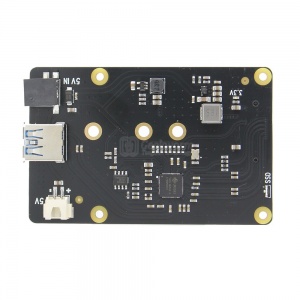
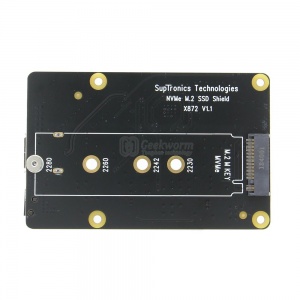
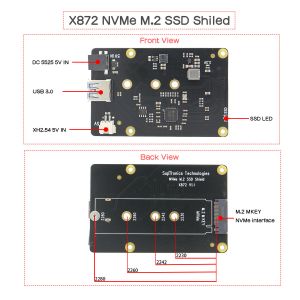
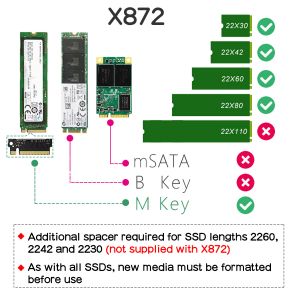
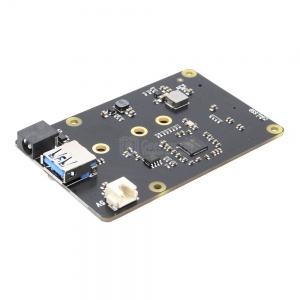
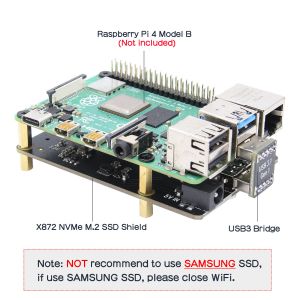
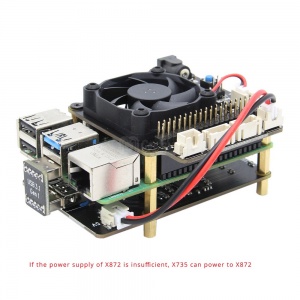
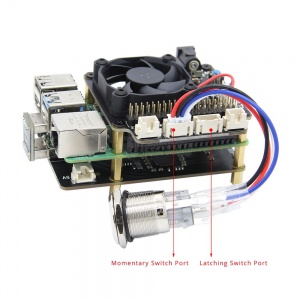
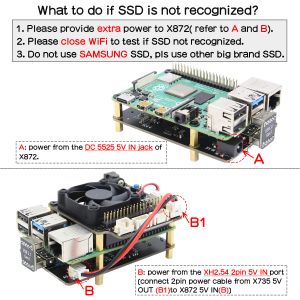
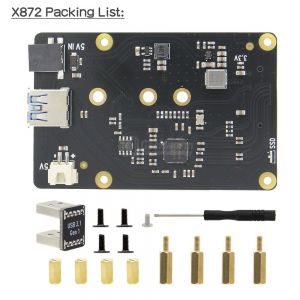
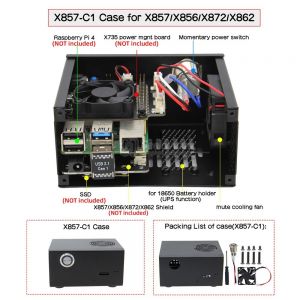
Enable comment auto-refresher
Anonymous user #2
Permalink |
Cindy
Anonymous user #1
Permalink |
Harry